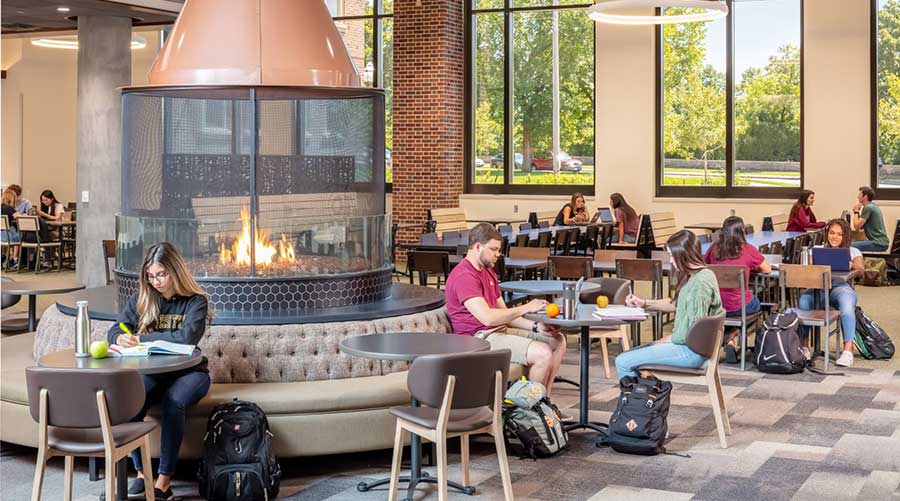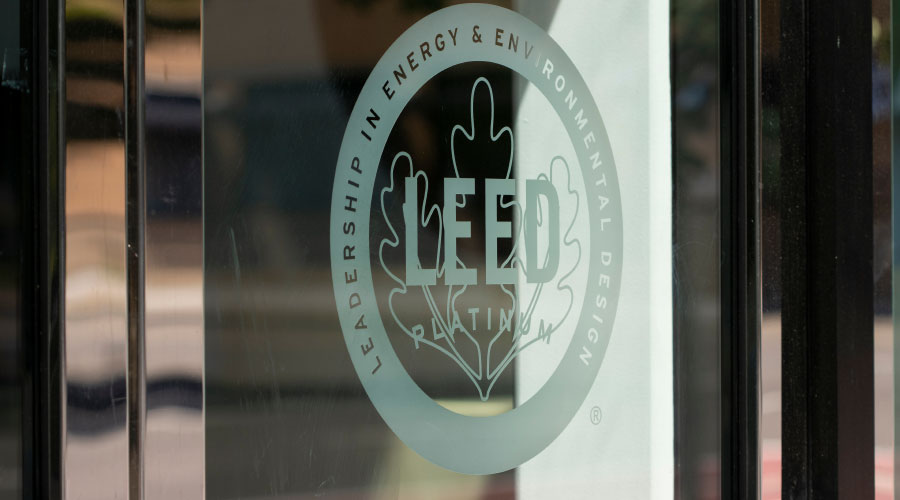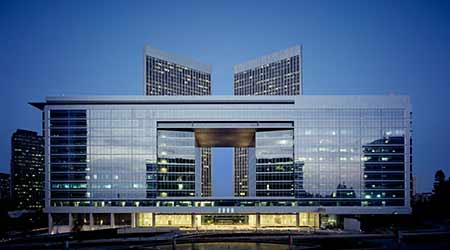 Low-flow toilets, zero-water-use urinals, and faucet aerators have helped Century Park in Los Angeles reduce water use by 21.2 million gallons per year.CBRE
Low-flow toilets, zero-water-use urinals, and faucet aerators have helped Century Park in Los Angeles reduce water use by 21.2 million gallons per year.CBRE4 Ways To Go Green In Existing Buildings
Here's a look at some of the best and most impactful ways to focus on sustainability in existing buildings.
OTHER PARTS OF THIS ARTICLEPt. 1: This Page
The average commercial building wastes 30 percent of the energy it consumes, says Energy Star. While many new buildings are constructed with energy-saving features, they are a tiny fraction of the overall population of buildings. “If you’re going to have an impact (on energy consumption), you have to work with existing buildings,” says Bob Best, head of energy and sustainability services with JLL.
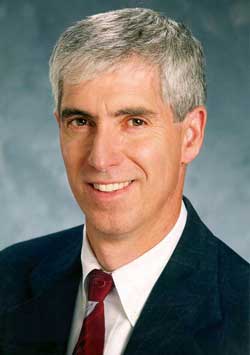 Dave Pogue, global director of corporate responsibility, CBRE
Dave Pogue, global director of corporate responsibility, CBRE To be sure, a growing number of facility managers are doing just that. CBRE and Maastricht University publish an annual review of the growth in green building certifications in the 30 largest U.S. markets, says David Pogue, global director of corporate responsibility. In 2005, approximately 5 percent of this square footage carried these designations, while in 2016, nearly 40 percent of the space did, Pogue says. And this doesn’t include facilities that pursue energy efficiency initiatives, yet don’t become certified.
Measures to green existing buildings can bring significant financial benefits. Energy can be a building’s fourth or fifth largest operating cost, says Richard Anderson, principal with CQI Associates. With minimal effort, many inefficiencies can be corrected, cutting costs by 6 to 7 percent, he says. And while water costs far less than electricity, deteriorating infrastructure is driving some water and sewer costs up by double digits, Anderson says. For instance, information from Baltimore City Department of Public Works shows many water and sewer rates rising 20 percent between 2016 and 2018.
Efforts to green existing building often focus on energy. Rachel Sowards, vice president of Paladino and Company, divides building owners and facility managers fall into one of three categories when it comes to boosting the energy efficiency of their existing facilities.
Those just starting out typically focus on understanding and benchmarking their operations.
A larger group consists of those who’ve aligned their capital investment budget with energy efficiency and sustainability initiatives to create more efficient buildings. “I expect this group to continue to grow,” Sowards says. “Once a facility owner or manager figures out how to assemble the pieces in the right order, the benefits are significant.”
Finally, there are the facility managers who have undertaken sizable renovations and repurposed their buildings to meet a market that’s committed to sustainability. “It’s a smaller group, but growing,” Sowards says.
Regardless of where a facility manager stands on that scale, there are opportunities to improve performance. The following strategies can help a facility manager to find the next step.
1. Benchmark to build a foundation
A first step in boosting the “greenness” of existing buildings is to determine where the building currently is, and where they’d like it to go. An operational audit can identify areas in which operations can be made more efficient, sometimes with no or modest capital investments. For instance, the engineering staff can check that the HVAC system’s hours of operations match the times at which the building is occupied, says Mike Alexander, vice president of sustainability services with Cushman & Wakefield. Timers and occupancy sensors can be installed, usually at little cost, to ensure equipment and systems run only when needed.
By benchmarking a function like energy or water use, against both an accepted standard (e.g., Energy Star), as well as the rest of the owner’s portfolio, engineers and energy managers can identify opportunities for improvement, Pogue says. They also might discover parts of the organization that can offer examples of practices to follow, he adds.
It’s not necessary to start from scratch when embarking on sustainability projects. Existing programs like LEED, GreenGlobes, and Energy Star can provide valuable information and guidelines, even if the facility manager isn’t going to pursue certification. This information can shortcut much work that otherwise would be necessary, says Sowards. For instance, LEED’s O&M (operations and maintenance) rating system provides a clear outline for effective retrocommissioning, as well as guidelines on purchasing and cleaning practices, she says.
2. Find quick wins
When beginning a sustainability initiative, identify projects that will show results with just modest investments of time and money, Sowards advises. These quick wins can build support for projects that require a greater commitment.
Vegetative roofs, for instance, “offer high visual impact and tell a good story,” Anderson says. More important, they provide legitimate benefits. “They’re like a big sponge.” That is, they hold water and mitigate the flow of storm water. That can benefit the many U.S. cities with antiquated storm water treatment systems that risk getting overloaded after severe storms. When that happens, both storm and sewer water can end up within the storm pipes, and the tainted water may flow, untreated, to streams and rivers.
In addition, if stormwater isn’t absorbed — again, a risk during severe storms, especially in cities with a high percentage of hard ground covering — it can run off to the streets and wash into waterways. Once there, it can negatively impact fish and plants, Alexander adds.
A thorough commissioning of the building’s systems and equipment also is key. Pogue notes that most buildings are designed and built to higher standards than they operate. The commissioning process can ensure all systems operate the way they’re supposed to. Many commissioning projects boast payback periods of six months or less, he says. In some cases, the local utility company will cover the cost.
The mistakes found through commissioning can be hard to believe. Anderson has seen dampers put in backward, exhaust fans that weren’t hooked up, damper controls on the air handling units that weren’t connected, and variable air volume systems that were installed backward. “It’s crazy, obvious stuff,” he says.
Moreover, when a facility is spending, say, $1 million on electricity each year, even a two percent inefficiency can boost costs by $20,000, says Bob DeMarke, vice president of asset services with Transwestern. To avoid that, the outside and internal air dampers need to seal completely, the fans need to run at their optimal speed, and other equipment needs to be kept tuned so it operates properly. “Don’t forget all the old technology,” he says. “There’s not much of a margin for error.”
Anderson recommends the California Commissioning Protocol as a guide. It provides an “excellent checklist,” he adds.
Retrofitting the lighting systems, if not already completed, can be a relatively simple way to reduce energy consumption, Alexander says.
One common energy waste is when the heating and cooling systems operate simultaneously, forcing each to work harder. A product known as an “interlock” can correct this, DeMarke says. An interlock consists of software and a controller that will shut off the heat when the cooling zone is open. “It eliminates the opportunity for simultaneous heating and cooling,” says Katie Sakach, senior vice president, asset services with Transwestern.
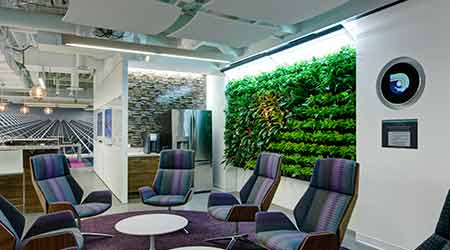
(A green wall can provide a range of benefits, offering a connection with nature and a calming atmosphere, while improving indoor air quality and acoustics. Credit: John Herbst, Transwestern)
3. Leverage technology
“Technology offers a new opportunity to improve operational efficiency,” Alexander says. New software can analyze data from the BAS to identify areas that can be made more efficient. For instance, sub-metering — capturing energy consumption data for individual buildings, floors, tenant space, or even specific devices — can “generate data that can guide management strategies, operational and investment decisions, and tenant interaction that ultimately results in significant energy-reduction benefits,” says a report by the U.S. General Services Administration: “Submetering Business Case: How to calculate cost-effective solutions in the building context.”
On-demand ventilation systems can help reduce energy consumption and costs, says Pete Miceli, vice president and regional engineering manager with Transwestern. “New technology allows us to measure directly the amount of oxygen in the air,” Miceli says. Rather than bringing in a fixed amount of outside air, the system monitors return air for carbon dioxide, and opens outside air dampers only when more oxygen is needed.
Most codes regulate the amount of air required in a building, Miceli says. Often, however, building systems overventilate, particularly in areas that get infrequent use. The fans and heating and cooling systems are working when they’re not needed. With on-demand ventilation systems, areas with highly variable occupancy, like conference rooms, might cut their HVAC costs in half, he estimates.
 Mike Alexander, vice president of sustainability services, Cushman & Wakefield
Mike Alexander, vice president of sustainability services, Cushman & Wakefield Technology also can cut the amount of water used for irrigation, Anderson notes. Some newer systems adjust the flow of water to reflect the amount already in the ground. Another, lower-tech option is to use cisterns to collect rainwater and use that for irrigation, he adds.
One tactic for boosting sustainability is using renewable energy, along with more traditional energy sources. This can offer both operational stability and savings. For instance, a building that can run on solar with a battery backup, even for a limited period of time, can remain operating even if the power goes down. “Renewables are not just a flash in the pan,” Anderson says. He sees renewables as the future of the industry.
The price of solar panels has come down significantly, Best notes. Moreover, facilities that aren’t candidates for the panels, perhaps because their roof space is limited, can participate in “solar community gardens.” These are community-shared solar arrays with grid-connected subscribers. The subscribers receive a bill credit as if the panels were on their own roof, according to the Solar Garden Institute.
Facility managers also can choose from an ever-expanding range of less toxic or nontoxic cleaning products. Moreover, the products are effective, Anderson says, noting that earlier offerings sometimes weren’t. Facility managers also should aim for 100 percent recycled content in paper products, he adds.
Technology is also being used to track building performance on environmental metrics. For example, the LEED Dynamic Plaque “is a building performance monitoring and scoring platform,” according to the U.S. Green Building Council. It keeps tabs on energy and water use and waste reduction, among other factors.
4. Focus on tenant health
Sustainability increasingly takes into account not just the environment, but tenant comfort and health, Sakach says. “A sustainable operation means considering the tenant, and their comfort and enjoyment of the facility.”
As an example, Sakach points to a “green” wall of grass or other plants. She and her colleagues were deciding between a video screen and a green wall for the main lobby of a Class A Property. The green wall won. It provides color, a connection with nature, and a calming atmosphere and appeals to multiple generations, she says.
What’s more, green buildings tend to boost productivity, Best says. Improved lighting and daylighting, for instance, can improve productivity by 5 to 18 percent, according to JLL.
By considering tenants’ legitimate comments and complaints, facility managers often can both improve occupant comfort and save energy, Anderson says. “If someone says they’re hot all the time, it means the space is energy inefficient. You need to address that,” he says.
Taking steps to boost the efficiency and comfort of existing buildings pays off for tenants, building owners, and the environment. “The greenest buildings are the ones we have,” Sowards says.
Karen Kroll, a contributing editor for Building Operating Management, is a freelance writer who has written extensively about real estate and facility issues.
Email comments to edward.sullivan@tradepress.com.
Related Topics:












